
Website owner: James Miller
CONICS. ELLIPSE, HYPERBOLA, PARABOLA, CIRCLE

Conic. A conic is any curve which is the locus of a point which moves in such a way that the ratio of its distance from a fixed point to its distance from a fixed line is constant. The ratio is the eccentricity of the curve, the fixed point is the focus, and the fixed line is the directrix. See Figure 1. The eccentricity is always denoted by e. Referring to Figure 1,

where dF is the distance of point P from the focus F and dD is its distance from the directrix. When e = 1, the conic is a parabola; when e < 1 it is an ellipse; when e > 1, it is a hyperbola.

Conics as cross sections of a circular cone. Conics are given by the intersection of a plane with a circular cone. The intersection will correspond to one of the conic curves (ellipse, hyperbola, parabola, etc.) depending on the angle at which the plane cuts the cone. See Figure 2. Because of this, conics are also called conic sections. Let φ be the acute angle that the intersecting plane makes with the axis of the cone and let α be the acute angle that the generator of the cone makes with the axis of the cone. Then
Value of φ |
Conic section created |
φ = 90o |
circle |
α < φ < 90o |
ellipse |
φ = α |
parabola |
φ < α |
hyperbola |
DEFINITIONS.
Chord of a curve. A line segment joining any two distinct points on the curve.
Focal chord of a conic. A chord passing through a focus of the conic.
Focal radius of a conic. A line segment joining a focus to a point on the conic.
Principal axis of a conic. The line passing through the focus perpendicular to the directrix.
Latus rectum of a conic. The chord passing through the focus parallel to the directrix.
Vertex of a conic. A point where the conic crosses the principal axis.

Referring to Figure 3, DF is the principal axis, V is the vertex, BB' is a focal chord, FB is a focal radius, and LL' is the latus rectum.
***************************
THE PARABOLA
***************************

Parabola. A parabola is the locus of a point which moves in a plane in such a way that its distance from a fixed point of the plane and from a fixed line of the plane are equal. Referring to Figure 1, a parabola is the locus of point P moving in such a way that always
dF = dD
where dF is its distance from the focus and dD is its distance rom the directrix.
Stated differently, a parabola is the set of all points in the plane that are equidistant from a fixed point and a fixed line in the plane.

Standard form of the parabola. The equation of a parabola assumes its simplest form (i.e. its reduced canonical form) when its vertex is at the origin and its axis coincides with one of the coordinate axes.

Axis coincides with the x axis. When the vertex is at the origin and the axis coincides with the x-axis, the equation of the parabola is
1) y2 = 4px
In this form the focus is at F(p, 0) and the equation of the directrix is x = - p. If p > 0, the parabola opens to the right. See Figure 4. If p < 0 , the parabola opens to the left. See Figure 5.
Note. The equation of this parabola centered at (x0, y0) is
(y - y0)2 = 4p(x - x0)
Axis coincides with the y axis. When the vertex is at the origin and the axis coincides with the y axis, the equation of the parabola is
2) x2 = 4py
In this form the focus is at F(0, p) and the equation of the directrix is y = - p. If p > 0, the parabola opens upward. See Figure 6. If p < 0 , the parabola opens downward. See Figure 7.
Note. Some authors use a different convention in regard to the standard form of the parabola. Some authors give the standard form as y2 = 2px, in which case the focus is at (½ p, 0) and the directrix is located at x = - ½ p.
**********************
THE ELLIPSE
**********************
Ellipse. An ellipse is a figure formed by a point which moves in the plane in such a way that the sum of its distances from two fixed points is constant. See Figure 8. The ellipse is the locus of point P moving in such a way that always

![]()
where q is a constant. The constant q is equal to the distance V'V (the length of the major axis).
Definitions, terms. The fixed points F and F' in Figure 8 are called the foci and the point C midway between them is called the center. The points V and V' are the vertices, the segment V' V is called the major axis, the segment B'B is called the minor axis, the line segment CV is called the semimajor axis and the line segment CB is called the semiminor axis. The principal axis is the major axis.
Equivalent definition of an ellipse. An equivalent definition of an ellipse is that it is the locus of a point P which moves in such a way that the ratio of its distance from a fixed point F to its distance from a fixed line D is a constant e < 1, called the eccentricity. In Figure 8, the fixed point is the focus F or F' and the fixed line is the directrix d or d'. The ratio FP/PD = F'P/PD' = e is the eccentricity. It can be shown that the eccentricity e is also equal to the ratio CF/CV.
We can take as a definition of an ellipse any property that defines it. An ellipse can also be defined as the result of a “uniform contraction” of a circle toward one of its diameters, a definition equivalent to the above.
Standard form of the ellipse. The equation of an ellipse assumes its simplest form (i.e. its reduced canonical form) when its center is at the origin and its principal axis coincides with one of the coordinate axes. Let a and b represent the lengths of the semimajor and semiminor axes, respectively. Then the standard form of the equation of an ellipse is either
![]()
or
![]()

according to whether the principal axis lies on the x axis or the y axis.
Note. If the ellipse is centered at (x0, y0) these formulas become
(x - x0)2/a2 + (y - y0)2/b2 = 1
and
(x - x0)2/b2 + (y - y0)2/a2 = 1
Principal axis is the x axis. When the center is at the origin and the principal axis is the x axis, the equation of the ellipse is

See Figure 9. The vertices are at V(a, 0) and V'(-a, 0). The length of the major axis is V'V = 2a and the length of the minor axis is B'B = 2b. The foci are on the major axis at F(c, 0) and F(-c, 0) where
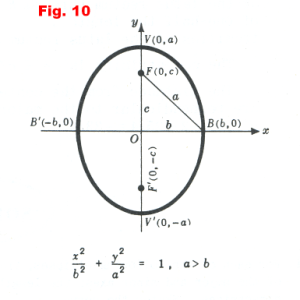
![]()
Principal axis is the y axis. When the center is at the origin and the principal axis is the y axis, the equation of the ellipse is
![]()
See Figure 10. The vertices are at V(0, a) and V'(0, -a). The length of the major axis is V'V = 2a and the length of the minor axis is B'B = 2b. The foci are on the major axis at F(0, c) and F(0, -c) where
![]()
In both cases, the length of a latus rectum is 2b2/a, the eccentricity is
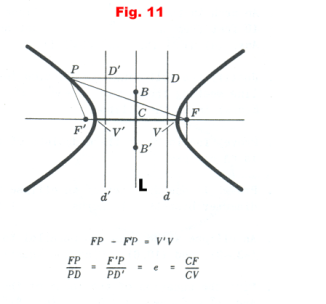
and the directrices are perpendicular to the major axis at distances
![]() a2/c or
a2/c or
![]() a/e from the
center.
a/e from the
center.
******************************
THE HYPERBOLA
******************************

Hyperbola. A hyperbola is the locus of a point which moves in the plane in such a way that the absolute value of the difference of its distances from two fixed points in the plane is constant. Referring to Figure 11, the hyperbola is the locus of point P moving in such a way that always
| FP - F'P | = q
where q is a constant. Referring to Fig. 11, q is equal to the distance V'V.
Definitions, terms. The fixed points F and F' in Figure 11 are called the foci and the point C midway between them is called the center. The points V and V' are the vertices. The segment V' V is called the transverse axis. The principal axis is the transverse axis. Let L be a line passing through C perpendicular to F'F. Then a certain line segment BB' defined on line L, having C as midpoint, is called the conjugate axis.
A hyperbola can also be defined as the locus of a point which moves in such a way that the ratio of its distance from a fixed point to its distance from a fixed line is a constant greater than one.
This definition gives only a single branch of the hyperbola. In Figure 11, the fixed point is the focus F (or F') and the fixed line is directrix d (or d'). The ratio is the eccentricity, e. The other branch is given by the conjugate focus and directrix.
Standard form of a hyperbola. The equation of a hyperbola assumes it simplest form (i.e. its reduced canonical form) when its center is at the origin and its axis coincides with one of the coordinate axes.
Principal axis is the x axis. When the center is at the origin and the principal axis is the x axis, the equation of the hyperbola is
![]()
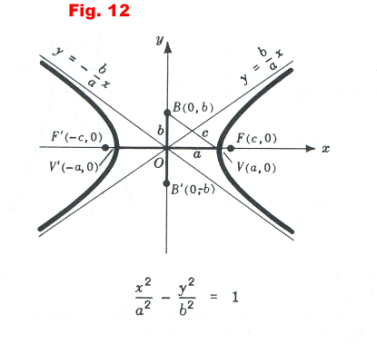
See Figure 12. The vertices are at V(a, 0) and V'(-a, 0). The length of the transverse axis is V'V = 2a. The extremities of the conjugate axis are B'(0, -b) and B(0, b) and its length is B'B = 2b. The foci are on the transverse axis at F(c,0) and F(-c, 0) where
![]()
Principal axis is the y axis. When the center is at the origin and the principal axis is the y axis, the equation of the hyperbola is
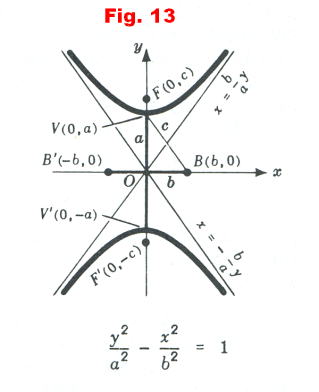

See Figure 13. The vertices are at V(0, a) and V'(0, -a). The length of the transverse axis is V'V = 2a.. The extremities of the conjugate axis are B'(-b, 0) and B(b, 0) and its length is B'B = 2b. The foci are on the major axis at F(0, c) and F(0, -c) where
![]()
In both cases, the length of a latus rectum is 2b2/a, the eccentricity is

and the directrices are perpendicular to the major axis at distances
![]() a2/c or
a2/c or
![]() a/e from the
center.
a/e from the
center.
Asymptotes of a hyperbola. The straight lines
![]()
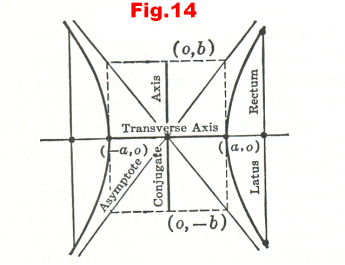
are called the asymptotes of the hyperbola 1). See Figure 13. The asymptotes pass through the corners of a rectangle defined by the lines x = a, x = -a, y = b, y = -b. See Figure 14. A convenient way to draw a hyperbola is to draw the rectangle, then draw the asymptotes through the corners, and then draw the hyperbola. The vertices are at the points where the sides of the rectangle cross the x axis. The foci are at a distance from the origin equal to one-half the diagonal of the rectangle.
The asymptotes of the hyperbola 2) are given by
![]()
In this case the rectangle is defined by the lines y = a, y = -a, x = b, x = -b.
The asymptotes have the property that the perpendicular distance from a point on a hyperbola to an asymptote approaches zero as the point moves indefinitely far from the center.
Def. Rectangular hyperbola. A hyperbola whose major and minor axes are equal. Its equation, in standard form, is x2 - y2 = a2. The equations of the asymptotes are y = x and y = -x.
Syn. equiangular hyperbola, equilateral hyperbola.
Def. Conjugate hyperbolas. Two hyperbolas such that the transverse axis of each is the conjugate axis of the other. The two hyperbolas

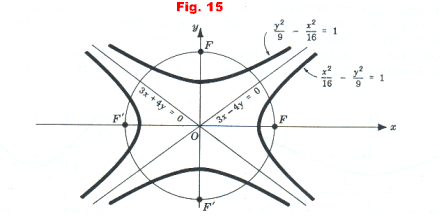
are conjugate hyperbolas. See Figure 15.
A pair of conjugate hyperbolas have the same center and the same asymptotes. Their foci lie on a common circle as shown in the figure.
************************************************************
Polar form of the equation of a conic. Let the focus of a conic be at the pole of a polar coordinate system and let the directrix be perpendicular to the polar axis and at a distance q to the left of the pole. Let e be the eccentricity. Then the equation of the conic in polar form is
![]()
If the directrix is located at a distance q to the right of the pole the equation is
![]()
Properties of Conics.
Parabola. A ray of light issuing from its focus is reflected by the parabola parallel to the axis of symmetry of the parabola. Applications: automobile headlight, search light, reflecting telescope.
Ellipse. A ray of light issuing from one of its foci and reflected by the ellipse passes through the other focus.
Hyperbola. A ray of light issuing from one of its foci is reflected by the hyperbola as if it originated from the other focus.
******************************
THE CIRCLE
******************************
Circle. A circle is a special case of an ellipse.
Circle - Standard form. The standard form of an equation of a circle centered at point (h, k) with radius r is
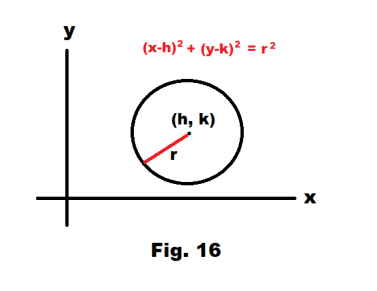
(x - h)2 + (y - k)2 = r2
See Fig. 16.
Circle - General form.
Ax2 + Ay2 + Dx + Ey + F = 0, A ≠ 0
x2 + y2 + 2dx + 2ey + f = 0

Circle on line segment P1P2 as diameter.
(x - x1)(x - x2) + (y - y1)(y - y2) = 0
where P1(x1, y1) and P2(x2, y2) are the end points of a diameter.
Three point form. If a circle passes through the three points P1(x1, y1), P2(x2, y2), and P3(x3, y3), its equation is given by
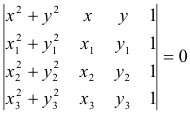
References.
Ayres. First Year College Mathematics. Chap. 52 - 54.
James and James. Mathematics Dictionary.
Jesus Christ and His Teachings
Way of enlightenment, wisdom, and understanding
America, a corrupt, depraved, shameless country
On integrity and the lack of it
The test of a person's Christianity is what he is
Ninety five percent of the problems that most people have come from personal foolishness
Liberalism, socialism and the modern welfare state
The desire to harm, a motivation for conduct
On Self-sufficient Country Living, Homesteading
Topically Arranged Proverbs, Precepts, Quotations. Common Sayings. Poor Richard's Almanac.
Theory on the Formation of Character
People are like radio tuners --- they pick out and listen to one wavelength and ignore the rest
Cause of Character Traits --- According to Aristotle
We are what we eat --- living under the discipline of a diet
Avoiding problems and trouble in life
Role of habit in formation of character
Personal attributes of the true Christian
What determines a person's character?
Love of God and love of virtue are closely united
Intellectual disparities among people and the power in good habits
Tools of Satan. Tactics and Tricks used by the Devil.
The Natural Way -- The Unnatural Way
Wisdom, Reason and Virtue are closely related
Knowledge is one thing, wisdom is another
My views on Christianity in America
The most important thing in life is understanding
We are all examples --- for good or for bad
Television --- spiritual poison
The Prime Mover that decides "What We Are"
Where do our outlooks, attitudes and values come from?
Sin is serious business. The punishment for it is real. Hell is real.
Self-imposed discipline and regimentation
Achieving happiness in life --- a matter of the right strategies
Self-control, self-restraint, self-discipline basic to so much in life